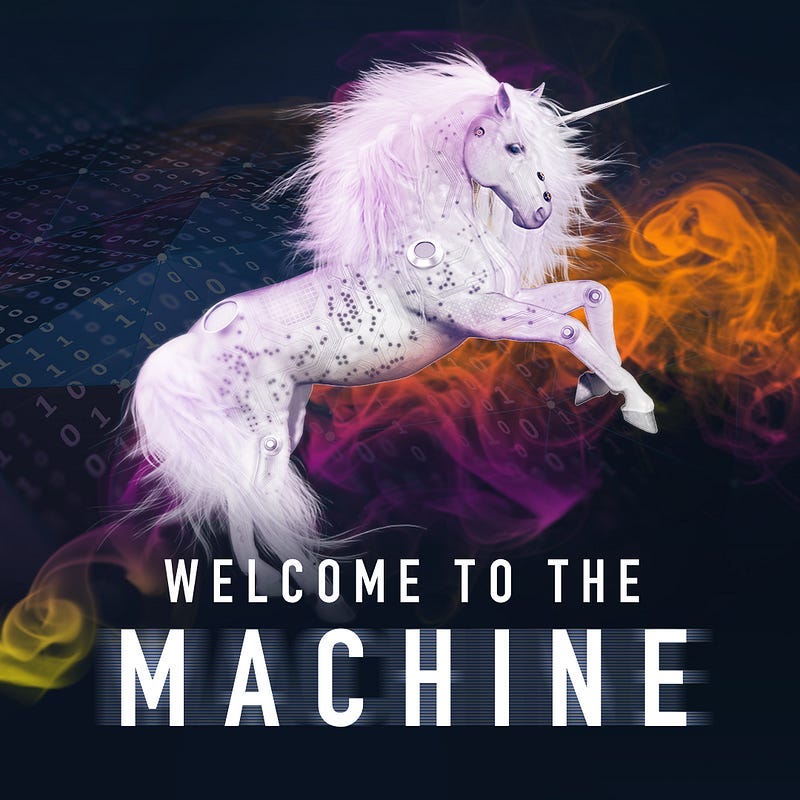Why Use a Unicorn to Depict Marketing AI
A few folks asked me why I used a unicorn on the Welcome to the Machine cover to depict marketing AI. The answer is simple. While like…
A few folks asked me why I used a unicorn on the Welcome to the Machine cover to depict marketing AI. The answer is simple. While like others I think AI will become woven into the very fabric of most marketers day-to-day tasks, there is a clear and evident hype curve about marketing AI that will leave many marketers disappointed.
AI or perhaps better described as machine learning has already proliferated many small tasks in the marketing department. From chatbots and analytics alerts to suggestions in our various advertising, marketing and social media platforms, AI makes incremental improvements in outreach.
Machine learning will continue to become a part of our everyday marketing tasks. It will become so pervasive that one much-discussed fear — losing a job to AI — is partially true. If a marketer doesn’t embrace the impact of algorithmic machine learning and fails to learn how to use it, then one can assume their skills will soon be antiquated.
Younger more nimble peers who are willing to support, enhance and improve their work with AI will be selected for new jobs and promotions. In the worst situations, the younger more AI literate employee will keep their a job while older more expensive and less nimble peers who refuse to adapt AI will find themselves looking for work.
I don’t see this loss of jobs as something that is unique to AI. Rather, it is a historical issue that impacts all professions through every era of technological innovation.
“Every generation, 20 to 30 percent of traditional jobs disappear,” said author and global marketing leader Seth Godin in an interview for the book. “That’s been going on for a hundred years. Ditch diggers feared the steam shovel, but some figured out how to become steam shovel operators, and punch card typists feared the terminal, but some of them figured out how to become programmers.”
Like the Web 2.0 social media wave before it, marketers need to pay attention to and accept machine learning-driven techniques. I wrote Welcome to the Machine to help myself and other marketers established in their careers understand and embrace AI.
Still, the presence of helpful algorithms has been turned into a variety of overhyped promises and dramatized fears. Thus the unicorn. Marketers need to keep their eyes wide open about machine learning. Here are three of the biggest myths I hear about marketing AI.
Myth 1: Every Marketing Platform has AI in It
The first cohort of marketers seeing the value of AI are those in technology companies selling marketing tools. And you can see the hype curve in every email, advertisement, web page, and promotional piece that’s pushed at you by them, particularly if you are involved in buying marketing technology or advertising in any way.
Are these technologies really serving the market with AI? Or have they created a software program that uses thousands or even millions of data points across all of their customers to offer you a neat application? Content marketing technologies like Grammarly and Scoop.it come to mind [Disclosure: This article was proofed with Grammarly].
Certainly, you can qualify AI as the presence of using algorithms to process data, and suggest an action.. For example, an AI enhanced marketing tool may suggest the optimal time to send an email or replicate a basic task like following someone back on a social network. These little machine assisted tasks are present in most platforms.
Hyping your brand as using AI because of such technologies is a bit, um, disingenuous. It’s kind of like saying you have a community-driven enterprise because your company lets people comment on your business Facebook page. Certainly, these applications provide a good introduction to machine learning and save lots of time, but this not marketing AI for your enterprise.
“AI analyzes data, makes assumptions, learns and provides predictions at a scale and depth of detail impossible to replicate by humans,” said Alexandre Gonfalonieri in his recent Medium article, ‘Is it really AI?’”
Strong AI will leverage most if not all of an entire enterprise’s datasets to provide significant insights, suggestions, and actions to better interface with and serve customers. These changes will provide marketing programs incremental growth and in a few cases home-run breakthroughs that simply were not possible with only human labor.
Fully realized, marketing AI represents a sea change that will literally change the entire way that a company approaches its customers and markets itself. Getting there requires major lifts beyond a major technology implementation. Consider the many cultural processes and approaches that will be affected, and also how brands find, clean and leverage enterprise-wide data. Most brands are just not there with their data (yes, this is myth 2).
In the context of what is possible, the marketing AI revolution as it is being sold to enterprises today by martech companies— in most cases — is a sham. In actuality, you see marketing programs that use predictive analytics or simple algorithmic scripts (think social media bots) in their software. These marketing technologies are overhyped as AI to compel purchases.
Powered by AI should be a red flag for marketing technology buyers. A unicorn may be present.
Suggestion: Dig deep and look under the covers. See whether or not a simple program has been deployed or if the system leverages your entire customer data to deliver a more powerful analysis and result.
Myth 2: Your Company Has Enough Data to Deploy AI
Unless your company or organization had the foresight to create and maintain a smart data governance policy across all of its platforms, AI will not be an easy lift. A successful AI initiative requires an incredible amount of data, so much data that you will be surprised at how much time your data science team spends acquiring and cleaning data.
Perhaps your brand has prepared for the eventual mining of that data to produce the insights, recommendations, and content/output. If that’s the case, then your initial data governance efforts will make implementation easier thanks to pre-existing efforts to clean that data.
If your brand is like most established brands, then you have incredibly large and disparate information systems that don’t talk well with each other. Systems range from CRM and product databases to marketing automation and online databases of cookied online visitors. You probably have dozens, if not hundreds or even thousands of corporate social media accounts. In their own right, these data sets represent months worth — perhaps years — of data preparation for your machine learning initiative.
Yes, you can purchase some of that data through large media companies like Nielsen. You can also access public data through the government. But you will still need to correlate that information back to your customers so your machine learning algorithm can begin training and learning the necessary patterns and probable outcomes (e.g. insights) you need for it to be successful.
This is a particularly daunting challenge for B2B or B2G brands. While marketers can definitively turn to some advanced techniques like Account-Based Marketing (ABM) to optimize their lead generation and conversion rates, B2B brands may not simply have enough data to deploy robust AI solutions.
Think about how many customers Boeing’s Commercial Aircraft Division has in the world. The number is in the hundreds. Hundreds of customers rarely produce hundreds of thousands of interactions to analyze.
My friend Andre Yee, founder and CEO of ABM company Triblio, has been exploring how to bring AI to the B2B marketplace.
“There are so many dimensions to a B2B buying cycle, anywhere from 20 to 25 to 35 meaningful variables that might give you an accurate model to predict propensity,” said Andre. “It’s not easy to pin down. It’s not just A-B testing. You will need several hundred thousand individual test cases, if not millions. If you don’t have enough data or the right data, then you’re subject to error and different problems in the model, what people call over-fitting or under-fitting in the model.”
The somewhat infamous AI portrait Edmond De Belamy fetched more than $400,000 in auction used fewer data points. But it did analyze every aspect of 10,000 well-regarded portraits spanning several centuries, and then created a human-guided portrait. Certainly the level and quality of clean portrait data was far above the norm. Obvious Art worked hard to make sure the information used to feed their AI GAN network was superior.
Suggestion: Consider what you want to use AI for in your company, and examine the data you already have available. When considering AI technology partners, understand the importance of this data, and if harvesting data is not a central point of conversation, run for the woods.
Myth 3: AI Replaces Marketers
I already noted that people that fail to evolve their skillsets to include AI tools would likely get displaced. That doesn’t mean that marketers will be replaced by AI units. Instead, they will get replaced by more capable humans who better understand modern marketing tools.
Of course, there will be exceptions to the rule. The junior intern who is paid to like every tweet mentioning the brand will get replaced. The data analyst who spends dozens of hours a week creating dashboards from your disaggregated data set will get replaced.
However, to implement AI, you need a human to train it and guide it. Performance needs to be managed. It takes humans to authorize new actions and marketing initiatives, and send new queries for the AI to analyze. The algorithm may need to be tweaked, or rewritten altogether. Iterative learning is the name of the game.
Further, there are skillsets that may never be replaced by machine learning. They are intrinsically human, and defy the basic benefits of data analysis. For example, you may use AI to help build a web page, but there are invariably designers guiding the machine learning, steering the writers and overarching design to meet the brand’s needs.
“Creativity is not being replaced by machines,” said Paul Roetzer, founder and CEO of the Marketing Artificial Intelligence Institute. “Human creativity is a unique thing. Strategy is another skill set that’s going to be extremely hard for machines to replicate. Empathy, emotion, those are traits and skillsets that are just going to be[hard for] machines to excel at… There may come a time where that changes, but right now, those things are unique to humans.”
In reality, machine learning serves the marketing department by performing time-consuming replicable tasks. Most marketers find such tasks boring. Here are some examples of tasks that AI will soon perform in almost every marketing shop:
Correcting audio and lighting in video raw footage
Writing reports for customers based on their usage patterns
Optimizing send times for email and social communications
Analyzing website and social network data to determine new customer opportunities
Finding commonalities between different customer cohorts
Proofreading blog posts, marketing reports, and press releases
You can add boring marketing tasks to the list from now until the end of the world. Are these tasks that most marketers want to do, or would they prefer an assist from their machine learning programs so they can focus on the creative works that they love?
Suggestion: Consider whether or not your work is repetitive and data-based. If so, consider moving towards more creative and strategic roles as your work may soon be replaced or a ta minimum supported by machine learning. To stay viable, don’t run from the machine, welcome it. Learn how to use it to make your marketing better, and become invaluable to the enterprise.








